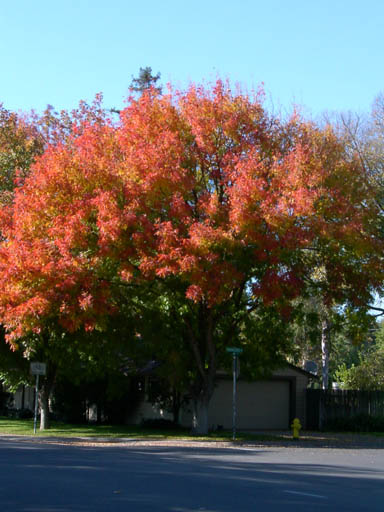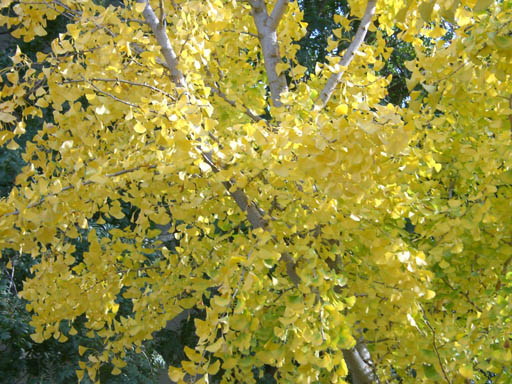Some of Our Favorite Trees!
written for the Davis Enterprise, September 26, 2002
"I want a tree that isn't messy, has deep roots, grows fast, doesn't need
pruning, has flowers and nice fall color, tolerates heavy soil and Davis
water, doesn't cause allergies, and never gets pests or diseases. Oh, yes,
and I'd like it to be native, and I'm going to plant it in my lawn. "
Well, don't we all? Since no such tree actually exists, it's important to
decide which criteria are most important. In computer-speak: if you were
to set up a database for tree characteristics, which fields would you use
to search by?
[The resulting table can be seen here. This article is about deciduous shade trees. For a table of evergreen trees, look here. For an article about evergreen trees, click here]
Selecting a tree is one of the most important decisions you make. A well-chosen and
properly trained tree adds thousands of dollars in value to your property,
providing beauty and shade. A poorly chosen tree is an expensive and
dangerous liability. People often choose trees for the wrong reasons, or
have difficulty setting their priorities.
Here are some of our favorite deciduous trees, in alphabetical order, with a few pros and cons:

Chinese pistache (Pistacia chinensis). This old favorite grows at a
moderate rate, has deep roots and bright fall color. Spectacular fall color and very low-maintenance, requiring little or no pruning once established. Very drought-tolerant
but can also take lawn watering. Females have red berries that attract
songbirds (and create some litter); male trees drop flowers in the spring.
Verticillium wilt is a root-infecting fungus that can be a problem in Stonegate, areas
north of Covell, and Mace Ranch neighborhoods. ------->>>
Chinese and Formosan flame trees (Koelreuteria spp.). Goldenrain tree (K.
paniculata) is the most common in this group, and the least desirable: a
fast-growing medium tree with showy yellow flowers in summer and
buff-colored pods in fall. Drought-tolerant and ok in lawns, but messy: reseeds
prolifically, and the box-elder bug can be an annoying pest. K. bipinnata
is similar, having yellow flowers in late summer and orange-red pods in
late fall; doesn't reseed much and doesn't get the bugs. K. elegans is the
striking tree on the corner of Eighth and L Streets, with yellow flowers in
fall followed by pretty pods. Doesn't reseed much and no bugs. Not common
in the trade, but usually available at the UC Davis Arboretum sales--the
event open to the public is in October, and monthly sales are held for
members (you can join at the door!).
Hackberry (Celtis sinensis, the Chinese hackberry, is the only species
common in the trade). Fast growing, spreading trees. Deep-rooted and very
drought-tolerant. Small red berries drop (and sprout), but aren't squishy.
A good fast-growing shade tree. Caveat: an unknown disease has killed some
older trees in Willowbank and in the neighborhoods near downtown Davis. [The Asian Woolly Hackberry Aphid has become an annoying pest of Chinese hackberry in the Sacrametnto Valley since this article was written. For more information click here.]
Linden (Tilia cordata is the Little-leaf linden, the most common in this area). Slow to moderate growth
rate, forming a nice pyramidal tree. Pretty yellow fall color. Deep roots,
no litter; good in lawns. No pruning required. Few pest problems, this
tree should be used more.

<<<<-------Maidenhair tree (Ginkgo biloba--grafted male clones only!). nearly ideal.
slow growth--18" per year. naturally forms a pyramid shape, but young trees
often lose their leaders and form a broader crown. brilliant gold fall
color, and then the leaves all drop at once (one week of raking). deep
roots, no litter, no maintenance, no pests. tolerates drought or lawn
water.
Maples (Acer spp.) Trident maple, Purpleblow maple, and Amur maple are
small, growing at a moderate rate, and have good fall color. New hybrids
between Red maple and Silver maple are becoming important shade trees,
usually listed under Acer x freemanii in reference books. These get big,
grow fast, and have great fall color. It's hard to keep track of all the
new varieties, but they mostly differ in growth rate, ultimate size and
shape, and have subtle variations in fall color. Maples will show leaf burn after hot weather or dry winds unless they are well-watered.
Oaks (Quercus spp.) are very diverse, but there are some drawbacks among
the deciduous species. Some eastern types (especially Scarlet oak) get
anemic due to our hard water, and many will show leaf burn after hot summer
weather if they don't get deep soakings. Native types can be fussy about
overwatering. Pin oak and Red oak have nice fall color, but the leaves
then turn brown, look ugly, and hang on and on and on until winter rains
finally batter them off. Valley oak is our stately native, growing 3' a
year to a great size. Young trees grow faster with summer watering. Willow
oak also grows well here. Both are deep-rooted and low-maintenance.
Pears (Pyrus calleryana hybrids). Bradford pear lines many streets in
Davis. Unfortunately, it can split apart after 10 - 15 years unless it is
carefully trained. The graceful Aristocrat pear, introduced a few years
later, proved to be the only Callery pear with messy fruit, and is prone to
mistletoe and fireblight. New introductions can be good choices, though
high-maintenance: Capital (very narrow column), Chanticleer (slightly
broader column), Redspire and Trinity (very similar varieties) are all
fast-growing, deep-rooted, tolerant of heavy soil and lawn watering, with
nice spring flowers and beautiful fall color. All need thinning to create
safe branch structures.
Smaller trees: Crape myrtles (Lagerstroemia hybrids), Crabapples (Malus
species and varieties), and flowering plums (Prunus blireiana and 'Krauter
Vesuvius') are all good small or medium trees. These grow about 3' per
year and have showy flowers in summer and spring, respectively. Some Crape
myrtles have nice fall color; new hybrids can tolerate lawn watering as
well as some drought. Crabapples all have showy flowers and can tolerate
heavy soil and lawn watering; look for disease resistant varieties. Plums
have the pretty red leaves and grow quickly. The two varieties mentioned
are nearly fruitless, unlike older types.
Sycamore/Plane tree (Platanus x acerifolia, the London Plane tree, is most
common). Very fast growth. Generally deep-rooted. High litter factor due to
seed balls, bark, small branches and large leaves, but nothing squishy.
Self-pruning (i.e., drops small interior branches, thinning itself). Two diseases make the leaves
unsightly but the tree grows fine in spite of them. Still, one of
the best really fast-growing shade trees.
Tulip tree (Liriodendron tulipifera). Moderate growth rate, very upright.
Generally deep-rooted; good in lawns. Low maintenance. Yellow fall color.
Flowering magnolias are sometimes also called Tulip tree; these are much
smaller, slow-growing flowering trees that need plenty of moisture.
Zelkova serrata. Fast growing, very large trees which resemble elms
(specimens line Elmwood Drive). Train carefully when young for good branch
structure, but then very low-maintenance. Nice yellow-to-purple fall color. Can develop surface roots with
age, but a good fast-growing shade tree.
Next column...The Also-Rans and the Bad Actors!
© 2008 Don Shor, Redwood Barn Nursery, Inc., 1607 Fifth Street, Davis, Ca 95616
www.redwoodbarn.com
Feel free to copy and distribute this article with attribution to this author.
Click here for Don's other Davis Enterprise articles
